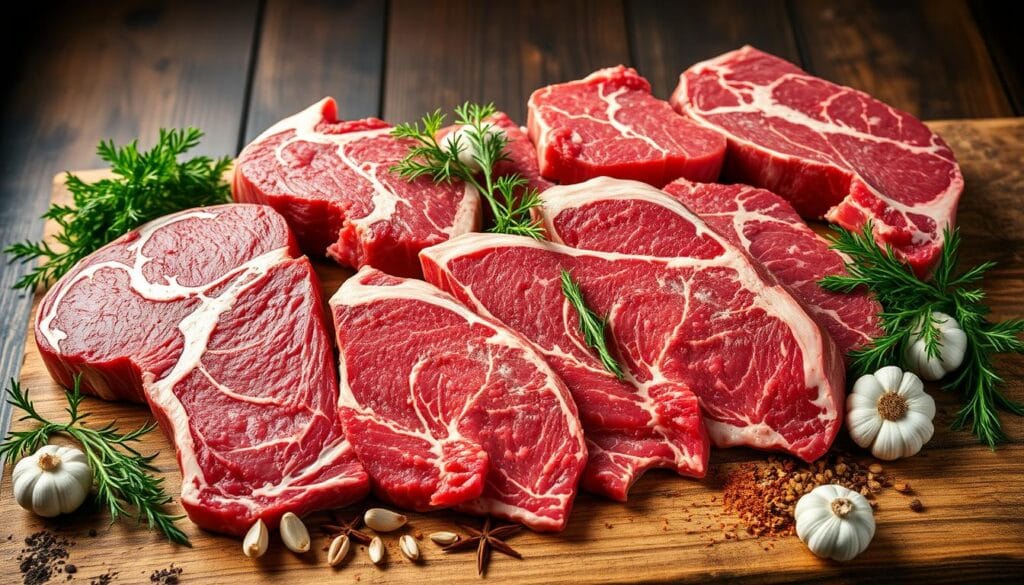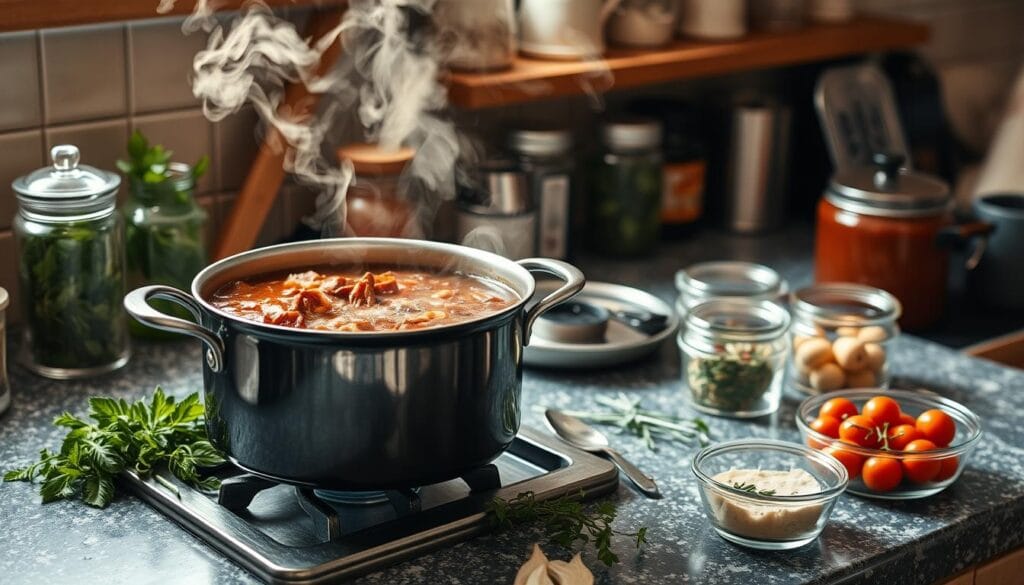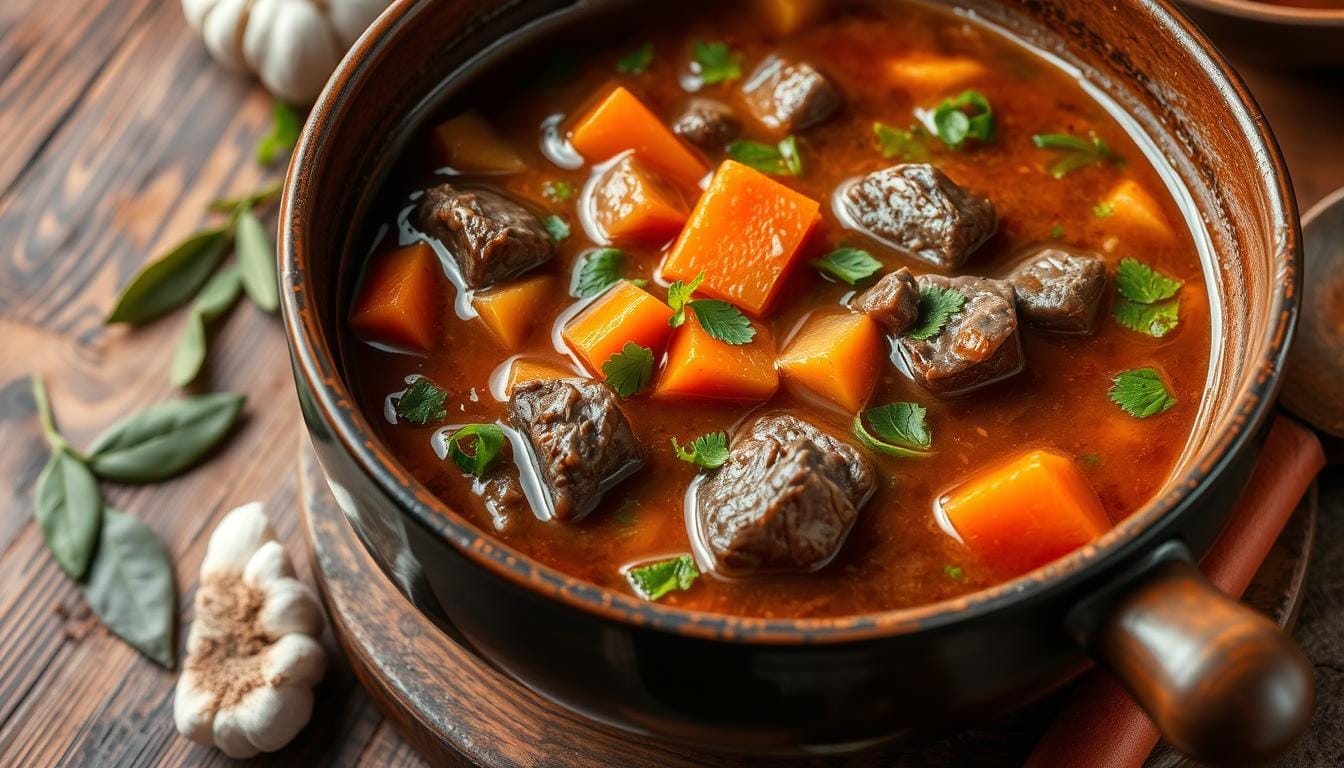As the air gets cooler and leaves start falling, I think of warm beef soup. It’s comforting and brings people together. The key to a great beef soup lies in selecting the most flavorful beef. Whether it’s Italian beef soup or French stew, the beef is crucial. Cuts like chuck roast offer amazing flavor and tenderness. When cooked slowly, they become incredibly tender.
Understanding Different Beef Cuts for Soup Making
Choosing the right beef cut is key to a delicious beef soup. Not all cuts are the same. Knowing their differences helps you pick the best for your soup.
Marbling and Its Impact on Flavor
Marbling, the fat inside the meat, affects flavor. Cuts with more marbling, like USDA Prime, taste richer. Leaner cuts, like USDA Select, might need marinating to taste better.
Fat Content and Tenderness Relationship
Fat content affects tenderness. Cuts with more fat, like chuck roast, get very tender when slow-cooked. Leaner cuts, like round, might need extra tenderizing for soup.
Best Cuts vs. Generic Stew Meat
Generic “stew meat” can be hit-or-miss. Choosing specific cuts like chuck roast or chuck shoulder makes your soup better. These cuts are tender and flavorful, thanks to their marbling.
Knowing about different beef cuts helps you make better soups. It lets you create dishes that are both satisfying and comforting.
What is the Most Flavorful Beef for Soup?
Choosing the right beef cut is key to a flavorful beef soup. While stew meat is cheap, the best cuts offer richer tastes. These cuts are perfect for soups.
The beef chuck roast is a top choice for soup. It comes from the cow’s shoulder and is fatty, making it great for slow cooking. As it cooks, it adds rich flavors to the broth, making the soup comforting.
Beef short ribs are also excellent for flavorful beef soup. They have a beefy flavor and tender texture. Oxtail is another great option, with its bone-in cut adding lots of flavor to the soup.
| Cut | Flavor Profile | Best Uses |
|---|---|---|
| Beef Chuck Roast | Rich, fatty, and flavorful | Soups, stews, and braises |
| Beef Short Ribs | Beefy, concentrated flavor | Soups, braises, and slow-cooked dishes |
| Oxtail | Collagen-rich, flavorful broth | Soups and stews |
These flavorful beef cuts are great in soups because they get better with slow cooking. Let them simmer slowly to infuse the broth with their flavors. This makes for a delicious and comforting soup.
“The most flavorful beef for soup is the kind that’s been allowed to simmer and meld its flavors into the broth, creating a truly satisfying and comforting dish.”
Chuck Roast: The Ultimate Soup Meat
The chuck roast is the top pick for making the best beef soup. It has just the right mix of fat and connective tissue. As it cooks slowly, these parts break down, making a broth that’s both rich and flavorful.
Why Chuck Roast Excels in Soups
The chuck roast is known for its great taste and tenderness when cooked slowly. The fat inside the meat bastes it, and the connective tissue melts, making it very tender. This makes the chuck roast perfect for soups, where it becomes incredibly tender and the broth gets very flavorful.
Proper Trimming and Preparation
To make the most of your chuck roast for soup, you need to prepare it right. First, remove any hard fat and silver skin. Then, cut the roast into 1 to 1.5-inch cubes for even cooking.
Optimal Cooking Temperature
For the best chuck roast in soups, cook it low and slow. Use your oven at about 325°F (165°C) or a slow cooker on low. This slow cooking breaks down the meat, making it tender and enhancing the soup’s flavor.
“The chuck roast is the unsung hero of beef soup recipes. Its rich, beefy flavor and tender texture make it the perfect choice for long-simmered, soul-warming soups.”
Bone-in Cuts and Their Rich Flavor Profile
For the most flavorful beef soup, use bone-in cuts like beef shank or short ribs. These cuts add depth and complexity to the broth. As they simmer, they release collagen and marrow, making the broth velvety and rich.
The long cooking time for bone-in cuts might seem like a drawback. But the wait is worth it. The broth becomes comforting and full of flavor, thanks to the breakdown of connective tissues.
If you’re using boneless beef, add marrow bones to your soup. The marrow melts into the broth, adding richness and nutrition. This simple step can turn a basic beef soup into a masterpiece.
| Ingredient | Benefit |
|---|---|
| Bone-in beef cuts (e.g., beef shank, short ribs) | Releases collagen and marrow, creating a rich, flavorful broth |
| Marrow bones | Adds velvety texture and nutritional value to the broth |

Using bone-in cuts and marrow bones opens up a world of flavor. Your beef soup will impress and captivate your guests.
Essential Preparation Techniques for Maximum Flavor
To bring out the bold, rich flavors of beef in a soup, you need a few key steps. These include proper searing, seasoning, and marinating. Each step can make your beef soup go from good to great.
Proper Searing Methods
Searing the beef before adding it to the soup is key. It creates a flavorful crust through the Maillard reaction. Make sure to pat the beef dry and season it well with salt and pepper before searing.
Use a hot, heavy-bottomed pan to get a deep, caramelized sear. Work in batches if needed to avoid overcrowding the pan.
Seasoning and Marinating Tips
Seasoning the beef well before searing is crucial for flavor. Don’t hold back on the salt and pepper. This helps the beef develop a savory crust.
While marinating can add depth, it’s not always needed for beef soup recipes.
Deglazing Techniques
After searing the beef, the pan will have flavorful browned bits. Deglaze the pan with red wine or beef broth. This will scrape up these bits and add them to the soup.
This process, along with adding aromatic ingredients like onions and garlic, creates a complex flavor base. It will make your beef soup even better.
“The secret to the best beef soup is all in the preparation. Searing the meat, seasoning it well, and deglazing the pan creates a depth of flavor that simply can’t be replicated any other way.”
Cooking Time and Temperature Guidelines
Creating the perfect beef soup is all about slow cooking. It’s important to let the beef simmer gently. This way, the connective tissues break down, and the flavors blend beautifully.
For stovetop cooking, simmer the soup at low heat for 2-3 hours. This method makes the beef tender and the broth rich. In the oven, braise the beef at 325°F (165°C) for 2-3 hours. This ensures the meat is tender and the flavors mix well.
Slow cookers work great too. Cook the soup on low for 8-10 hours, or high for 4-5 hours. This long cooking time makes the beef tender and the broth thick. Add delicate veggies like carrots and potatoes in the last hour to avoid overcooking.
The soup is ready when the meat is tender and the broth is thick. This makes the soup velvety and delicious. Slow cooking may take time, but it’s worth it for a flavorful and comforting soup.
| Cooking Method | Cooking Time | Cooking Temperature |
|---|---|---|
| Stovetop | 2-3 hours | Simmer on low heat |
| Oven | 2-3 hours | Braise at 325°F (165°C) |
| Slow Cooker |
| Low or High |
Remember to add any delicate vegetables, such as carrots and potatoes, during the last hour of cooking to prevent them from becoming overcooked.
Storage and Reheating Best Practices
Storing and reheating your delicious beef soup is key for keeping its flavor and convenience. To keep your soup fresh and tasty, follow these tips:
Refrigerating Beef Soup
Leftover beef soup can be stored in an airtight container in the fridge for up to 3-4 days. Make sure the soup cools down completely before refrigerating to avoid bacterial growth.
Freezing Beef Soup
You can freeze your beef soup for up to 3 months for longer storage. Use airtight containers or heavy-duty freezer bags, leaving space for expansion. Thaw the soup in the fridge overnight before reheating.
Reheating Beef Soup
To enjoy your reheating soup, warm it gently on the stovetop over medium-low heat, stirring now and then. If it’s too thick, add some broth or water to get the right consistency. Make sure the soup heats up to 165°F (74°C) all the way through before serving.
Beef soup often tastes better the next day as the flavors blend more. With the right storage and reheating, you can enjoy your beef soup for days.

Conclusion
The most flavorful beef for soup is the chuck roast. Other cuts like short ribs or shanks are also great. Choosing the right cut, searing, seasoning, and slow cooking are key.
Adding aromatic ingredients, wine, and cooking for a long time makes the soup rich and satisfying. This way, you get a flavorful beef soup that’s perfect for cold weather.
With these homemade soup tips, you can make your beef soup as good as a restaurant’s. Knowing how to pick and prepare beef makes your soup better. It becomes a dish that warms your body and soul.
For the best best beef for soup, focus on the details. The cut and cooking methods matter a lot. By getting these right, you’ll make flavorful beef soup that everyone will love.

